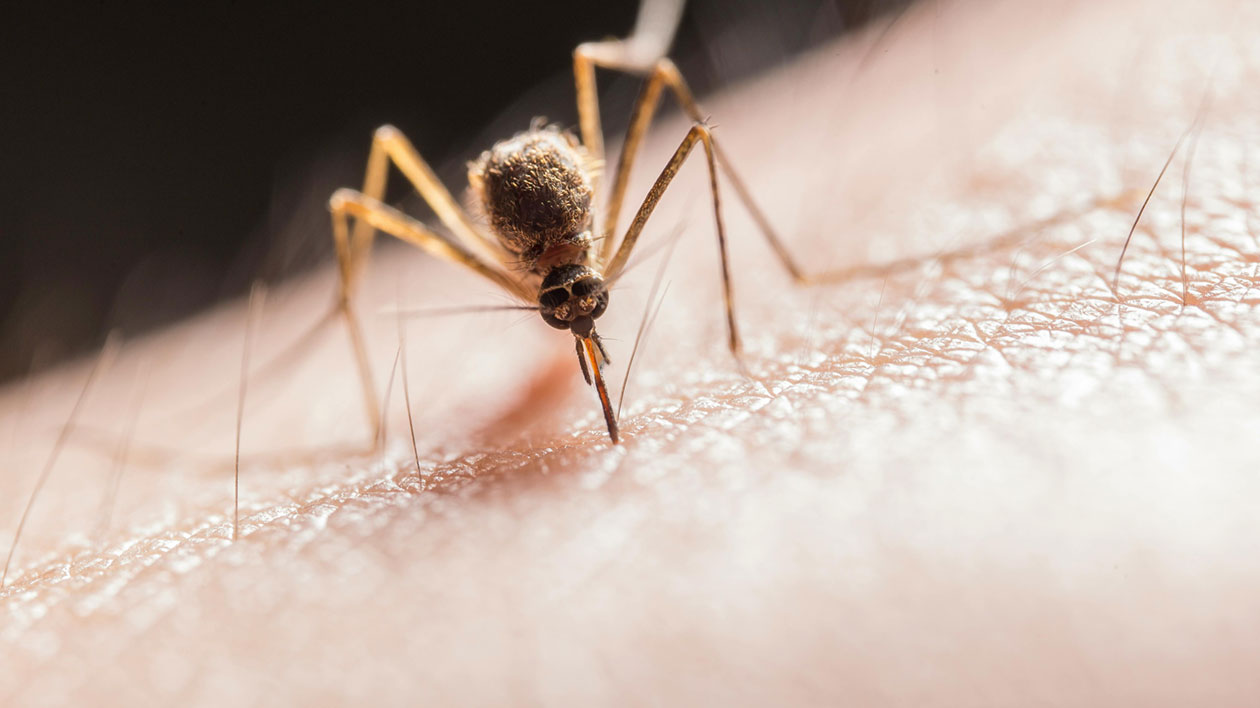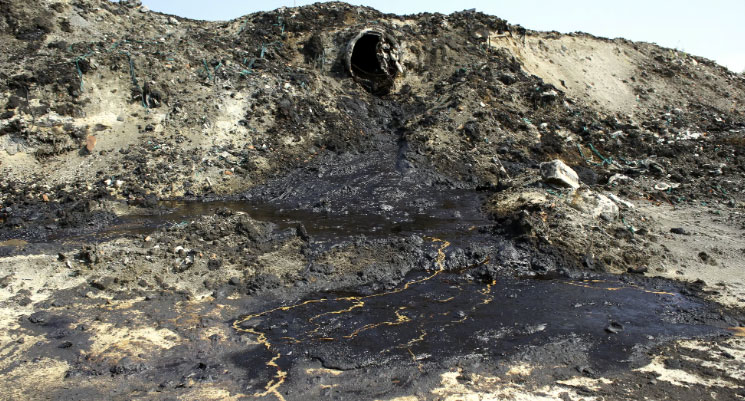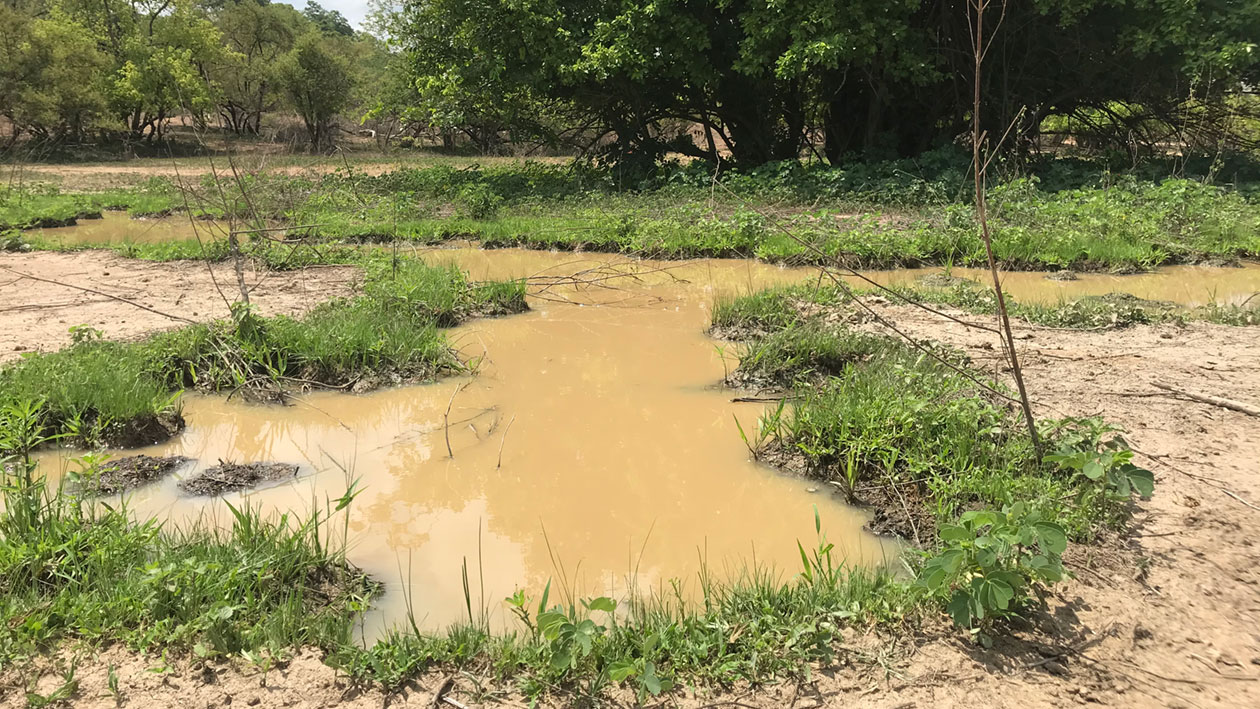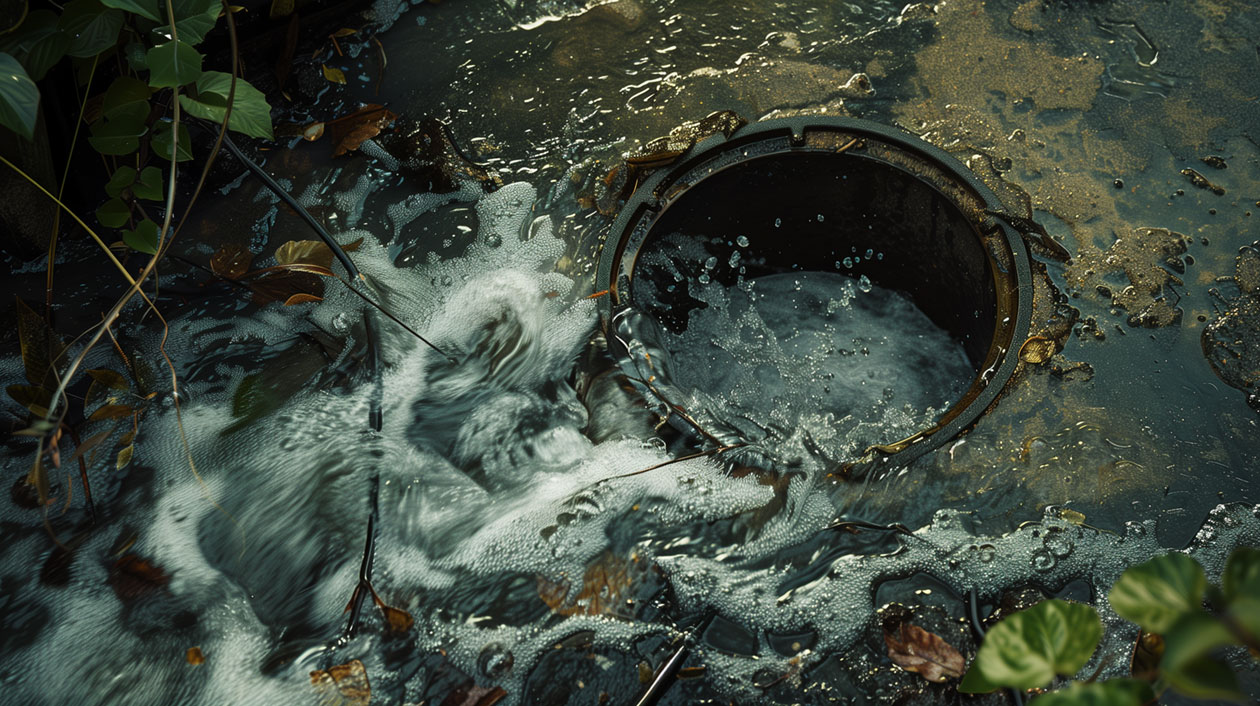The hidden environmental impact of blocked drains is a serious issue. A staggering 75% of sewer flooding is directly caused by blockages in sewers, according to Thames Water, a major UK water company. This statistic underscores the importance of understanding and addressing the problem, not just for individual homeowners but for the health of our environment as a whole. This guide will explore the hidden environmental impact of blocked drains and provide practical solutions for prevention and remediation.
In this guide:
Water Pollution from Blocked Drains
One may seldom consider the path water takes after we use it, but the drainage system is a pivotal part of our urban infrastructure. Blocked drains, whether due to accumulated waste, grease, or invasive root systems, prevent water from flowing naturally. This stagnation can lead to the backflow or overflow of dirty water, introducing various pollutants, bacteria, and harmful substances into the environment, which can infiltrate natural waterways and lead to widespread contamination.
When water pollution occurs due to blocked drains, the implications are severe. Ingesting or coming into contact with contaminated water can cause illnesses such as gastroenteritis, hepatitis, and even neurological disorders in humans. For the environment, the dissemination of pollutants disrupts ecosystems, affects plant growth, and results in the death of aquatic organisms. This tangled web of consequences shows how imperative it is to ensure our drainage systems remain unblocked and function efficiently.
Case studies: Areas affected by significant water pollution due to blocked drains
- In developing countries, blocked drains are a prevalent issue leading to the spread of diseases such as cholera and dysentery, especially in densely populated urban areas. For instance, case studies in cities like Mumbai, India, demonstrate how monsoon floods exacerbate the situation by overwhelming drainage networks.
- Industrial regions, such as Flint, Michigan, faced critical health crises when blocked and corrupt systems caused severe pollution to drinking water sources, leading to long-lasting health effects on the local populace.
Breeding Grounds for Mosquito and Pest Infestation
When our drains become blocked, they do more than just inconvenience us — they create the perfect environment for pests and mosquitoes to thrive. Stagnant water in blocked drains is an ideal breeding ground for these creatures, which can lead to a spike in pest-related problems within our communities.
Blocked drains often go unnoticed until they start to affect our daily routines. However, the stagnant water that accumulates is the first invitation for mosquitoes to settle in. These pests lay their eggs in standing water, and within days, what was once a minor blockage can become a significant public health concern.
Health Risks From Mosquito and Pest Infestation
The presence of mosquitoes and pests poses severe health risks. Mosquitoes are notorious for spreading diseases such as malaria, dengue fever, Zika virus, and West Nile virus. Similarly, pests like rodents can carry harmful bacteria that can lead to food poisoning and other health issues. The risk increases when these creatures make their way from the drains into our homes.

The Perils of Soil Contamination
When our drainage systems fail, it’s not just standing water we need to worry about. One of the most concerning consequences of blocked drains is soil contamination. Overflow from these blockages doesn’t simply vanish; it seeps into the ground, where it begins affecting the very foundation of our local ecosystems.
Clogged drains can lead to overflowing contaminated water, which quickly permeates the surrounding soil. This can result in a cascade of adverse effects, often hidden from the naked eye but with far-reaching implications for environmental health.
Impact on Agriculture and Vegetation
Soil that has been compromised by pollutants cannot support agriculture or sustain local vegetation effectively. Harmful chemicals and waste products can disrupt plant growth, degrade crop quality, and ultimately, cause serious damage to agricultural output. This outcome is not only a concern for ecological diversity but also poses a significant risk to food security.
Long-term Effects of Soil Toxins
The long-term presence of toxins in soil leads to detrimental effects on crucial organisms, such as earthworms, which play a key role in nutrient recycling and soil structure maintenance. Losing these organisms disrupts the careful balance of our ecosystem, causing a domino effect with potentially irreversible damage.
- Soil Contamination: The overflow from blocked drains leads to an immediate and severe contamination of the soil, altering its composition and health.
- Agricultural Impact: Contaminated soil undermines local agricultural efforts by hampering plant growth and risking the introduction of pollutants into the food chain.
- Long-Term Ecological Harm: Persistent soil contaminants can eradicate vital organisms like earthworms, crucial for soil fertility and structure, leading to broader ecological issues over time.

Understanding the Climate Impact: How Blocked Drains Contribute to Greenhouse Gas Emissions
When it comes to discussing the environmental repercussions of blocked drains, we often overlook a silent but significant issue: their contribution to the increase in greenhouse gas emissions. The intersection of waste management and environmental health is crucial, particularly as it pertains to the climate crisis we face today.
Blocked drains create an anaerobic environment where organic matter cannot decompose properly. This setting is conducive for the production of methane, a potent greenhouse gas that is over 25 times more effective at trapping heat in the atmosphere than carbon dioxide. Consequently, the neglected issue of blocked drains might play a larger role in contributing to climate change than is commonly acknowledged.
Improper Waste Management Exacerbates the Problem
When waste isn’t disposed of correctly, it can lead to blockages that exacerbate methane emissions. Materials that should be recycled or composted end up decomposing in roadside drains and sewers, adding to the existing environmental burden. The key to mitigating these emissions lies in better waste management strategies and public awareness about the importance of disposing of waste responsibly.
Efforts to Mitigate Greenhouse Gas Emissions from Drainage Systems
Thankfully, there are efforts in place aimed at reducing the environmental impact of drainage systems. These include:
- Implementing greener infrastructure solutions such as bioretention systems and green roofs to reduce the runoff that leads to blockages.
- Promoting public education campaigns to inform communities about the consequences of blocked drains and how to prevent them.
- Improving waste management practices, which encompasses regular drain cleaning, recycling programs, and the proper disposal of fats, oils, and greases.
By taking collective action to address the causes of blocked drains and their resulting greenhouse gas emissions, we can make significant strides towards a healthier environment and a more stable climate.
Floods and Property Damage Due to Inadequate Drainage
The environmental impact of blocked drains is not limited to just ecological ramifications; it also significantly affects our communities and economies. Instances of property damage resulting from drain blockages and the subsequent inundation can be disastrous. Floodwater can swiftly permeate homes and businesses, causing substantial structural damage and the loss of personal belongings.
Economic and Emotional Strains on Communities
When floodwaters recede, they often leave behind a trail of economic strife and emotional distress. Affected communities must bear the cost of repairs, clean-ups, and replacements of damaged infrastructure. On a personal level, the floods can trigger acute anxiety and long-term psychological effects, as the victims come to terms with the losses incurred.
Ecosystem Disruption from Drain Blockages
How a single blocked drain can reverberate throughout an ecosystem: It begins with stagnant water, often invisible to the casual observer, yet capable of setting off a catastrophic chain reaction within the environment. A blocked drain, choked with debris and waste, not only halts the flow of water but also disrupts the delicate balance of local ecosystems. Standing water can create unnatural pools that alter the habitat, affecting flora and fauna that rely on a specific ecological balance to thrive.
The domino effect: from small organisms to large predators: The repercussions of a blocked drain are felt through the food chain. Aquatic organisms, such as insects and fish, are among the first to suffer, as water quality deteriorates rapidly in the absence of proper drainage. This in turn affects the species that feed on them, including birds and larger mammals. The contamination spreads, impacting not only the organisms directly dependent on the water source but also predators and scavengers within the ecological web.
Protection of local biodiversity through proper drain management: Maintaining free-flowing drains is not just a matter of convenience; it is essential for preserving local biodiversity. Blocked drains can lead to the loss of native species, some of which may be critical to the ecosystem’s function or even endangered. Effective drain management helps to safeguard these species by preventing habitat alteration and ensuring that pollutants do not enter the ecosystem unfiltered. Proactive measures and community involvement in maintaining clear drains can make a significant difference to environmental health, protecting our natural heritage for future generations
The Grave Public Health Risks of Ignored Blocked Drains
When we discuss the environmental impact of blocked drains, the conversation often leans towards ecological effects. However, the ramifications extend far beyond the environment, gravely affecting public health. Blocked drains, while seemingly a minor inconvenience, can, in fact, become vectors for a host of health hazards.
Blocked drains create conditions ripe for bacteria and mould growth, leading to skin infections, respiratory problems, and gastrointestinal illnesses. Water stagnation can encourage the breeding of pests such as mosquitoes, which can spread deadly diseases like malaria and dengue fever. Furthermore, the indirect consequences of contaminated water supplies can ripple through communities, compromising cleanliness and sanitation.

Awareness Campaigns and Public Education On Health and Environmental Safety
Knowledge is power in battling the health risks associated with blocked drains. Public education and awareness campaigns play a pivotal role in informing citizens about the dangers of neglecting proper waste disposal and drainage maintenance. Such initiatives can encourage proactive behaviours that safeguard community health and the environment.
Policies and Systems in Place to Protect Public Health
- Environmental Regulations: Governments have enacted regulations that mandate proper waste management and drainage systems to prevent blockages and subsequent health risks.
- Public Health Policies: These are designed to ensure that there are adequate resources and responses in the event of health crises arising from drainage issues.
- Infrastructure Investments: By investing in robust sewage and drainage infrastructure, cities can mitigate the risks of blockages and their associated health dangers.
Blocked drains are not just an inconvenience; they are a critical public health issue. It is imperative to acknowledge this fact and take collective action to address the risks head-on, ensuring the safety and well-being of our communities.
Sewage Overflows: A Menace to the Environment
When drains become blocked, one of the most alarming consequences is the overflow of sewage. This hazardous event poses serious threats to our environment, tarnishing the natural beauty and balance of ecosystems. Understanding the severity of these incidents is crucial in driving efforts to prevent them.
Blocked drains can lead to an alarming situation where sewage systems are pushed beyond their limits. When this happens, the excess waste has nowhere to go, resulting in overflows that spill into streets, rivers, and surrounding land. These incidents are not only unpleasant but also signify a major environmental emergency.
According to a national guide on sewerage system overflows, “In many countries, stormwater and sewage are conveyed in common pipe networks designed to spill into the receiving environment during large rainfall events. These are known as combined sewers. Most sewerage systems in Australia are different and operated as separate systems that are not designed to transport stormwater. Some combined systems were constructed in Australia in the late 19th and early 20th Century, however, most have since been separated into stormwater and sewerage systems.” [Natural Resource Management Ministerial Council, 2004]
Impact of Raw Sewage on Waterways and Land
The introduction of raw sewage into the environment can have catastrophic effects. Into waterways, it can deplete oxygen levels and release harmful pathogens, while on land, it can seep into the soil, affecting plant life and contaminating groundwater.
- Water Contamination: When sewage enters rivers and lakes, it can lead to eutrophication, where the increased nutrients foster excessive plant growth and decay, robbing aquatic life of vital oxygen.
- Soil Degradation: Sewage spills directly affect the soil’s composition and can take a long time to rehabilitate, making the land less fertile and disrupting local agriculture.
Long-Term Solutions to Upgrade Sewage Handling to Prevent Overflows
To mitigate these risks, it’s imperative to implement long-term solutions for sewage management. This includes upgrading current infrastructure to handle larger volumes of waste, regular maintenance to prevent blockages, and education on proper waste disposal practices.
- Infrastructure Modernisation: Investing in modern sewage systems can better withstand the demands of growing populations.
- Maintenance and Education: Regular drain cleaning and raising public awareness about what can and can’t be disposed of via drains are vital steps toward preventing blockages that lead to overflows.
The Plight of Aquatic Life Amidst Drainage Issues
The repercussions of blocked drains on aquatic life are multifaceted and alarming. These blockages can lead to reduced water quality, decreased oxygen levels, and a buildup of toxins—all of which create an inhospitable environment for fish and other water-dwelling creatures. Furthermore:
- Toxic substances can leak into water bodies from stagnant pools created by blockages, posing a threat to the delicate balance of aquatic ecosystems.
- Trash and debris that gather at blockage sites can entangle and injure aquatic wildlife, often resulting in decreased mobility or death.
- Altered flow patterns can disrupt breeding and feeding grounds, leading to a decline in fish populations and unhealthy rivers.
Efforts to Restore Habitats Disrupted by Pollution and Waste
Amidst the bleak outlook, there is a gleam of hope as communities and environmental organizations rally to turn the tide against aquatic destruction. Initiatives include:
- Implementing clean-up operations to remove waste and obstructions, thus revitalising water flow and water quality.
- Advocating for better waste disposal practices to prevent future blockages from occurring.
- Collaborating with local governments to enforce stronger regulations on environmental protection, mitigating the accumulation of pollutants.
Prevention
Preventing blockages in the first place is the most effective way to protect the environment from the consequences of blocked drains. By implementing these preventative measures, you can significantly reduce the risk of sewage overflows and the associated environmental damage.
- Regular Maintenance: Regularly inspecting your drains for signs of blockage, such as slow drainage, gurgling noises, or unpleasant odours, is crucial. It’s essential to remove hair, grease, and other debris that can accumulate in your drains.
- Proper Disposal: Avoid flushing harmful substances down the drain, such as sanitary products, cooking oil, grease, coffee grounds, food scraps, and hair. Dispose of these items responsibly in designated bins or by following local disposal guidelines.
- Water Conservation: Reduce your overall water consumption by taking shorter showers, fixing leaky faucets, and watering your garden efficiently.
- Grease Traps: Install grease traps in your kitchen sinks to prevent grease from accumulating in your drains and causing blockages.
- Tree Roots: If you have trees growing near your drains, ensure they are not encroaching on the pipes. Tree roots can grow into drains and cause significant blockages.
- Professional Inspections: Schedule regular professional drain inspections to identify and address potential problems before they lead to blockages.
Remediation
If you experience a blocked drain, it is important to address the problem promptly to minimise the environmental impact. While professional cleaning is often the best option, there are some DIY solutions you can try for minor blockages.
- Professional Drain Cleaning: If your drains are blocked, contacting a professional drain cleaning service is the most effective solution. They have specialized equipment and expertise to clear blockages safely and efficiently.
- DIY Solutions: For minor blockages, you can try using a plunger, drain snake, or baking soda and vinegar mixture. However, be cautious as these methods may not be suitable for all types of blockages. Always wear gloves and protective eyewear during any DIY drain cleaning.
- Government Initiatives: Some governments have implemented initiatives to promote sustainable drainage and waste management. These initiatives often involve public education campaigns, infrastructure upgrades, and regulations aimed at reducing the occurrence of blockages.
Throughout our exploration of the environmental impact of blocked drains, we’ve uncovered the various ways in which clogged drainage systems can wreak havoc on the world around us. From the alarming water pollution concerns to the threats posed to public health, the issues are multifaceted and deeply interconnected.
Remember, environmental stewardship begins with the individual, and there is no action too small when it comes to protecting our planet. Challenge yourself and others to be vigilant and proactive. Unblock the potential for change, and watch as it ripples out to benefit our world.
[1] Thames Water. Blocked drains and sewers can cause flooding. [Leaflet] Retrieved from https://www.hillingdon.gov.uk/media/2418/Prevent-blocked-drains-and-sewers/pdf/t2Thames_Water_2.pdf?m=1593431921567.



